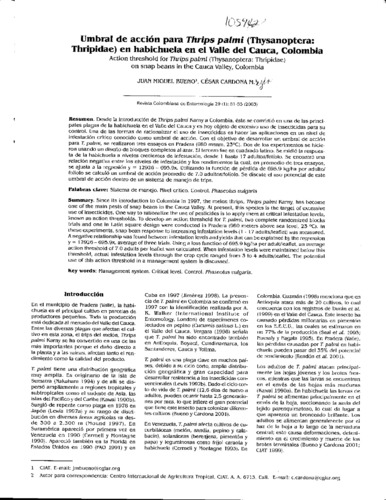Umbral de acción para Thrips palmi (Thysanoptera: Thripidae) en habichuela en el Valle del Cauca, Colombia = Action threshold for Thrips palmi (Thysanoptera: Thripidae) on snap beans in the Cauca Valley, Colombia
Desde la introducción de Thrips palmi Karny a Colombia, éste se convirtió en una de las principales plagas de la habichuela en el Valle del Cauca y es hoy objeto de excesivo uso de insecticidas para su control. Una de las formas de racionalizar el uso de insecticidas es hacer las aplicaciones en un nivel de infestación crítico conocido como umbral de acción. Con el objetivo de desarrollar un umbral de acción para T. palmi, se realizaron tres ensayos en Pradera (980 msnm, 23°C). Dos de los experimentos se hicieron usando un diseño de bloques completos al azar. El tercero fue en cuadrado latino. Se midió la respuesta de la habichuela a niveles crecientes de infestación, desde 1 hasta 17 adultos/folíolo. Se encontró una relación negativa entre los niveles de infestación y los rendimientos la cual, en promedio de tres ensayos, se ajusta a la regresión y = 12926 - 695.9x. Utilizando la función de pérdida de 695.9 kg/ha por adulto/ folíolo se calculó un umbral de acción promedio de 7.0 adultos/folíolo. Se discute el uso potencial de este umbral de acción dentro de un sistema de manejo de trips. = Since its introduction to Colombia in 1997, the melón thrips, Thrips palmi Karny, has become one of the main pests of snap beans in the Cauca Valley. At present, this species is the target of excessive use of insecticides. One way to rationalize the use of pesticides is to apply them at critical infestation levéis, known as action thresholds. To develop an action threshold for T. palmi, two complete randomized blocks triáis and one in Latin square design were conducted in Pradera (980 meters above sea level, 23 °C). In these experiments, snap bean response to increasing infestation levéis (1-17 adults/leaflet) was measured. A negative relationship was found between infestation levéis and yields that can be explained by the regression y = 12926 - 695.9x, average of three triáis. Usinga loss function of 695.9 kg/ha per adult/leaflet, an average action threshold of 7.0 adults per leaflet was calculated. When infestation levéis were maintained below this threshold, actual infestation levéis through the crop cycle ranged from 3 to 4 adults/leaflet. The potential use of this action threshold in a management system is discussed.

